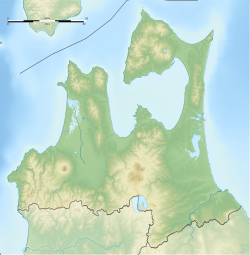三内丸山遺跡 | |
 Reconstructed six-pillar structure and long pit-dwelling at Sannai-Maruyama | |
| Location | Aomori, Japan |
|---|---|
| Region | Tōhoku region |
| Coordinates | 40°48′37″N 140°41′51″E / 40.81028°N 140.69750°E |
| Area | 40 hectares (400,000 m2; 99 acres) |
| History | |
| Periods | Early–Middle Jōmon period, Heian period, Muromachi period |
| Site notes | |
| Excavation dates | 1953-1967,1976-1987 |
| Archaeologists | Keio University, others |
| Public access | Yes (archaeological park) |
| Website | sannaimaruyama |
The Sannai-Maruyama Site (三内丸山遺跡, Sannai-Maruyama iseki) is an archaeological site and museum located in the Maruyama and Yasuta neighborhoods to the southwest of central Aomori in Aomori Prefecture in northern Japan, containing the ruins of a very large Jōmon period settlement. The ruins of a 40-hectare (400,000 m2; 99-acre) settlement were discovered in 1992, when Aomori Prefecture started surveying the area for a planned baseball stadium. Archaeologists have used this site to further their understanding of the transition to sedentism and the life of the Jōmon people. Excavation has led to the discovery of storage pits, above ground storage and long houses. These findings demonstrate a change in the structure of the community, architecture, and organizational behaviors of these people. Because of the extensive information and importance, this site was designated as a Special National Historical Site of Japan in 2000.[1], and a UNESCO World Heritage Site as part of the Jōmon Prehistoric Sites in Northern Japan collection in 2021. Today the public can visit the site, its various reconstructions of Jōmon structures, and a museum that displays and houses artifacts collected on the site, which have collectively been designated an Important Cultural Property[2]
- ^ "三内丸山遺跡". Cultural Heritage Online (in Japanese). Agency for Cultural Affairs. Retrieved 25 March 2020.
- ^ "青森県三内丸山遺跡出土品". Cultural Heritage Online (in Japanese). Agency for Cultural Affairs. Retrieved 24 April 2020.

